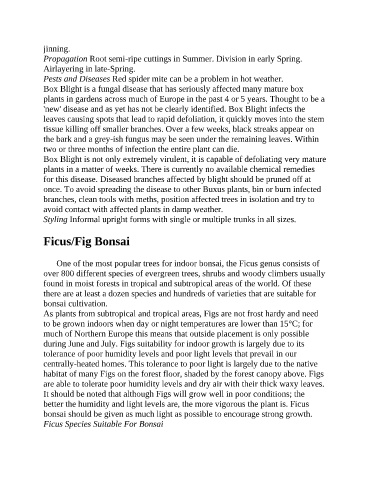Page 184 - Tài liệu cây cảnh Bonsai4me Bonsai Basics
P. 184
jinning.
Propagation Root semi-ripe cuttings in Summer. Division in early Spring.
Airlayering in late-Spring.
Pests and Diseases Red spider mite can be a problem in hot weather.
Box Blight is a fungal disease that has seriously affected many mature box
plants in gardens across much of Europe in the past 4 or 5 years. Thought to be a
'new' disease and as yet has not be clearly identified. Box Blight infects the
leaves causing spots that lead to rapid defoliation, it quickly moves into the stem
tissue killing off smaller branches. Over a few weeks, black streaks appear on
the bark and a grey-ish fungus may be seen under the remaining leaves. Within
two or three months of infection the entire plant can die.
Box Blight is not only extremely virulent, it is capable of defoliating very mature
plants in a matter of weeks. There is currently no available chemical remedies
for this disease. Diseased branches affected by blight should be pruned off at
once. To avoid spreading the disease to other Buxus plants, bin or burn infected
branches, clean tools with meths, position affected trees in isolation and try to
avoid contact with affected plants in damp weather.
Styling Informal upright forms with single or multiple trunks in all sizes.
Ficus/Fig Bonsai
One of the most popular trees for indoor bonsai, the Ficus genus consists of
over 800 different species of evergreen trees, shrubs and woody climbers usually
found in moist forests in tropical and subtropical areas of the world. Of these
there are at least a dozen species and hundreds of varieties that are suitable for
bonsai cultivation.
As plants from subtropical and tropical areas, Figs are not frost hardy and need
to be grown indoors when day or night temperatures are lower than 15°C; for
much of Northern Europe this means that outside placement is only possible
during June and July. Figs suitability for indoor growth is largely due to its
tolerance of poor humidity levels and poor light levels that prevail in our
centrally-heated homes. This tolerance to poor light is largely due to the native
habitat of many Figs on the forest floor, shaded by the forest canopy above. Figs
are able to tolerate poor humidity levels and dry air with their thick waxy leaves.
It should be noted that although Figs will grow well in poor conditions; the
better the humidity and light levels are, the more vigorous the plant is. Ficus
bonsai should be given as much light as possible to encourage strong growth.
Ficus Species Suitable For Bonsai

